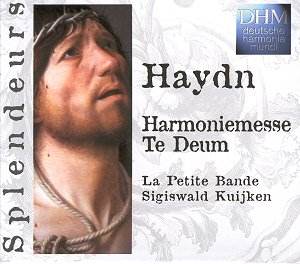Haydn’s
late, great Mass settings are the logical culmination of his
work as a symphonic composer. The Harmoniemesse is
the last of the six and was completed in 1802, employing a large
orchestra with flutes, oboes, clarinets, bassoons, horns, trumpets
and drums, as well as an organ part. It is from this large and
prominent wind section that the name comes; the Austrians referring
to wind ensemble music as Harmoniemusik. Like all of
Haydn’s late Mass settings there is an inherent confidence and
certainty in the music, born not only of steadfast religious
conviction, but also from the composer’s own advanced age and
absolute mastery of his art.
It
is over a decade since this recording by the period instrument
group La Petite Bande under its director Sigiswald Kuijken first
appeared, but it has lost none of its freshness and élan
in the intervening years. One of the great glories of the
period instrument movement was the rediscovery of the sound
of classical winds playing in ensemble. In this work, which
relies so heavily on the wind sections, the advantages of period
instruments really show through. The very opening chord of the
Kyrie takes on a special hue when given into the hands of truly
wooden woodwinds. Beautiful intonation and careful blend of
the sounds is ubiquitous. Unlike modern winds, whose design
feature is to sound individual and distinctive, classical winds
are meant to blend together – especially notable in the sound
of period clarinets and bassoons – notwithstanding the prominence
of the jaunty rapid bassoon solos in the concluding Dona Nobis
Pacem – a particularly jolly kind of Haydnesque peace. The brass
instruments are played with considerable gusto, but the narrow
bores of the trumpets and horns allow power without excessive
volume. This enables Kuijken to balance the highpoints with
brass and drums against his choir of 25 singers (six voices
per part, with seven basses) without risk of the orchestra dominating.
The DHM engineers have captured this careful balance of parts
excellently.
The
choir suffers occasionally from a rather hard-edged sound in
the soprano voices. This is notable particularly in the faster
moving chordal sections of the Gloria and Credo, and in some
rather aggressive phrase endings in louder sections. They are,
nonetheless, a dexterous ensemble and capable of beautiful phrasing
and line in other places. Considerable agility is shown in the
rapid patter of the Benedictus – an unusual departure from the
more usual soprano solo at this point.
Like
the orchestra, the solo singers are a well-blended group. All
the soloists are frequently to be heard in recordings with the
continental period-instrument groups and seem perfectly at home
with the sprightly tempi and delicate fluctuations of Kuijken's
interpretation. They are usually used as a quartet ensemble
to counter the choir. There is particularly good ensemble singing
in the Agnus Dei, in which Sandra Piau just occasionally floats
out of the texture in a lovely cantilena. It is all very nicely
judged.
The
coupling is the famous C major Te Deum, for choir
and large orchestra. To the scoring of the Harmoniemesse Haydn
adds a third trumpet and a lovely trio of trombones. Again,
period instruments really show to advantage here – there is
power and dignity but even with the trombones at full blast
there is always tight rhythmic control and a clearly defined
balance between choir and orchestra. Kuijken’s opening tempo
is not as fast as some recent recordings but he is not a sluggard
either. The violin figurations that accompany the whole opening
section are played with verve and cleanliness. As in the mass,
there is a hint of tightness in the upper voices of the choir
at moments of passion, and this is unfortunate, but not so serious
as to detract markedly from the overall quality of the performance.
As a period instrument version of one of the less-frequently
recorded late Haydn Masses I would be quite happy to live with
this version.
Peter
Wells

![]() Sandra Piau (soprano), Monika Groop (mezzo), Christoph Prégardien (tenor)
Harry van der Kamp (bass)
Sandra Piau (soprano), Monika Groop (mezzo), Christoph Prégardien (tenor)
Harry van der Kamp (bass)![]() DEUTSCHE
HARMONIA MUNDI 74321 935492 [51.43]
DEUTSCHE
HARMONIA MUNDI 74321 935492 [51.43]





